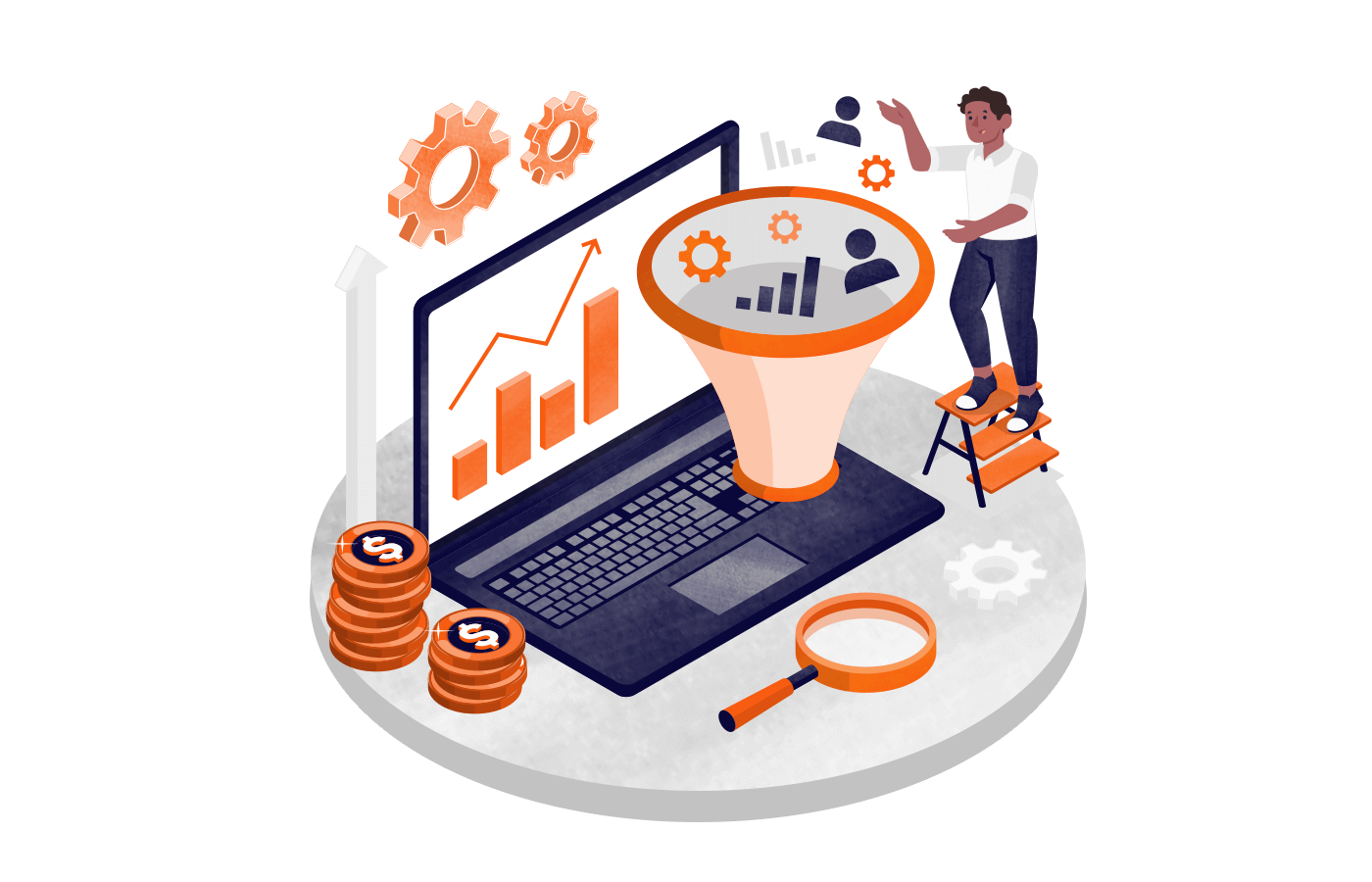If your landing page gets 20,000 visitors every month, resulting in 200 leads and, ultimately, 25 paying customers, your website visitor-to-lead conversion rate is 1%. What if you wanted to generate 50 customers each month?
You could try and double the traffic and hope that it improves your leads, or you could simply improve your conversion rate from 1% to 2% and end up doubling the number of leads.
More traffic doesn’t equate to more leads or more sales. This is why instead of worrying about where to get more traffic from, businesses should focus on making the most of whatever traffic is already flowing into their digital marketing assets such as websites and landing pages.
Not just a strategy or a bunch of tactics, Conversion Rate Optimization (CRO) is actually an approach that helps you optimize what you already are spending on. So it helps you get more, for less giving a massive boost to your marketing campaigns’ ROI.
The Basics—What is Conversion Rate Optimization (CRO)?
What is a Conversion?
To start with, a conversion is any desired action that you want your landing page or website visitors to complete.
It doesn’t always have to be a sale. As a matter of fact, it could mean different things for different businesses, even varying from campaign to campaign depending upon marketing goals and objectives.
E.g.s of, Conversions.
- More signups for an email newsletter
- More downloads of a PDF lead magnet
- Increased online purchases
- Increased webinar registrations
- Enhanced number of online form completions
What is Conversion Rate?
A conversion rate is a metric that helps you measure conversions. It tells you how many visitors to a landing page (or website) took the desired action.
It’s usually expressed as a percentage of the total traffic sent to that landing page.
E.g., of the Conversion rate calculation for a Landing Page.
CRO = [(Number of newsletter signups)/ (Total number of visitors to the page)] * 100
Conversion rates help you measure, compare and contrast the performance of various marketing channels.
A high conversion rate implies that your target audience (the traffic being sent over to the landing page) loves this well-optimized funnel, because of which they are encouraged to take positive actions (registrations, sign-ups, purchases).
What is a Good Conversion Rate?
Conversion rates are not only sensitive to many factors but also highly contextual. Some factors that strongly influence the conversion rates are:
- Marketing channel—FB ads, Google ads, email marketing, etc.
- Industry type
E.g., high ticket real estate will convert differently as compared to groceries or daily consumables
- Product type or Offer size
E.g., low priced offers are more likely to convert as compared to high ticket ones
- Audience demographics
E.g., Black Friday sales season in the US.
- Audience Behavior
E.g., Mobile vs. Desktop, Android vs. Apple device users
- Audience temperature—Warm, Hot, or Cold
E.g., your email list which trusts you and has already bought from you before will convert better than cold traffic from Facebook or Google ads.
B2B and B2C Conversion Rates
FirstPageSage, a California-based Digital Marketing agency, did the below study on conversion rates. It includes data from its B2B and B2C clients collected between 2016 and 2021.
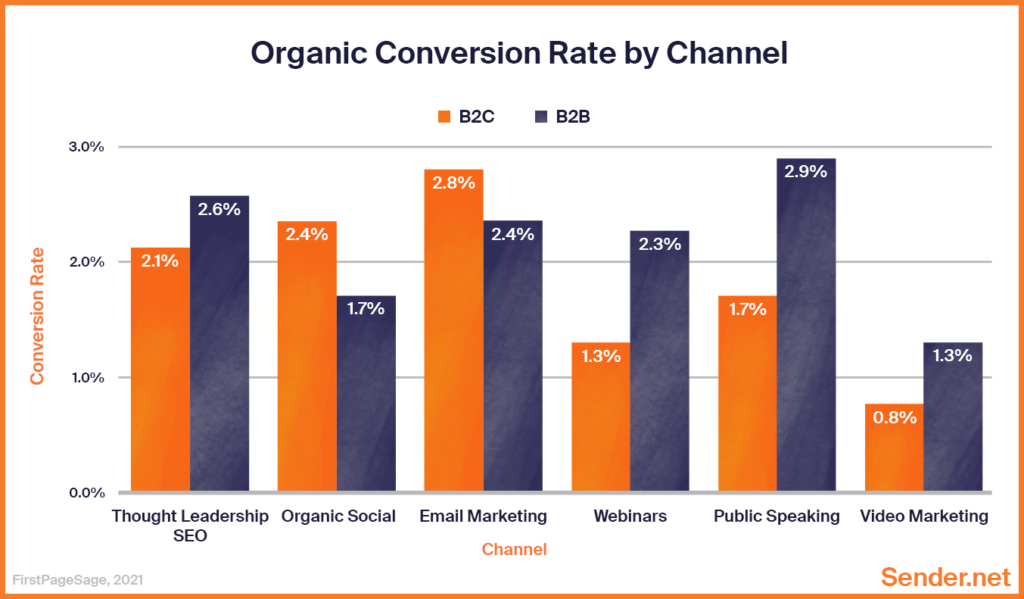
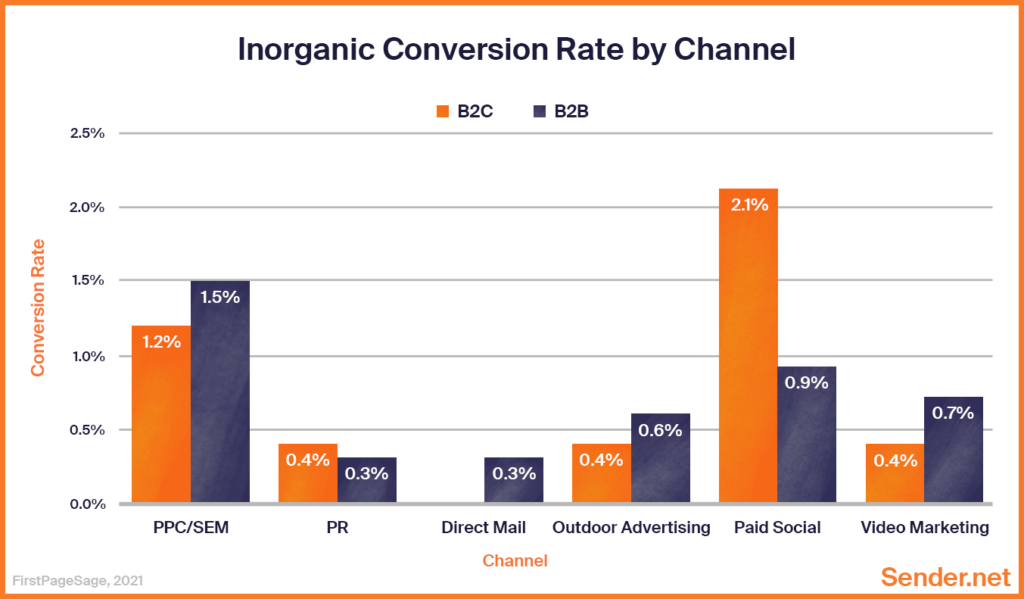
Ecommerce Conversion Rates
The average e-commerce website conversion rate generally ranges between 1-3%. However, according to one study, it globally stood at 2.58%.
The below infographic illustrates the online shopping conversion rates for the B2C e-commerce industry worldwide in 2021.
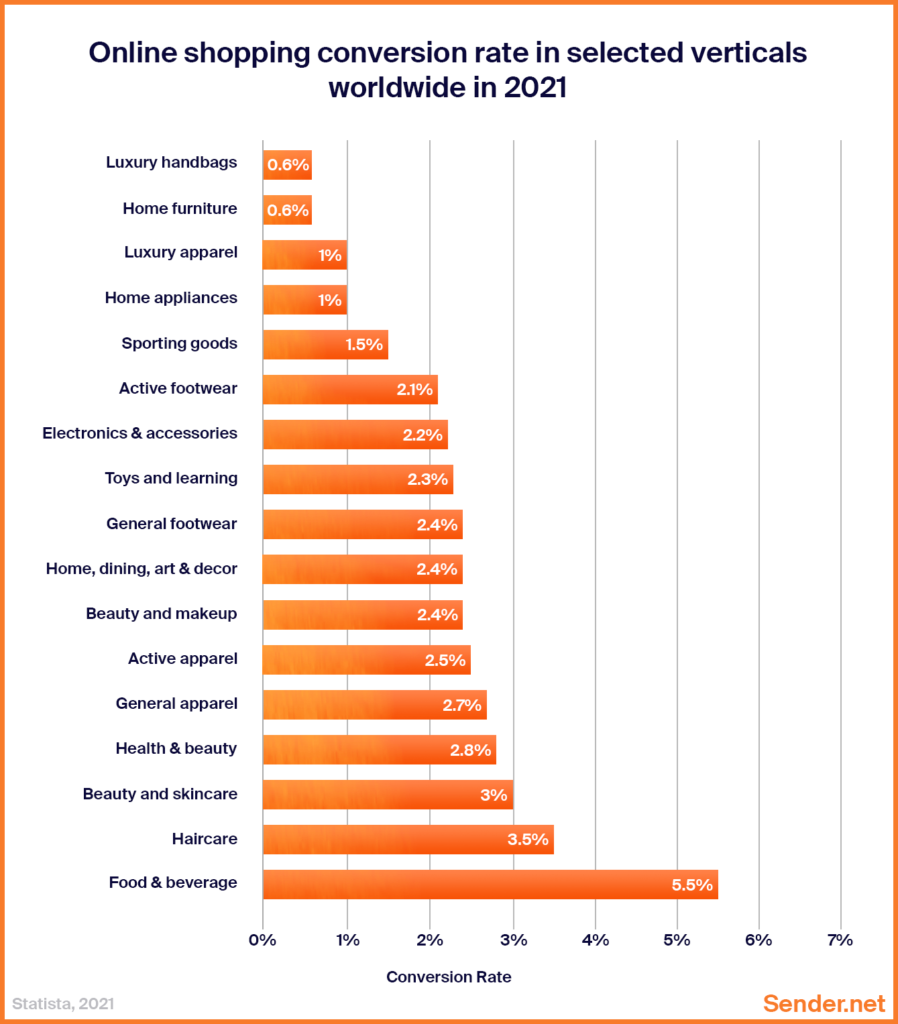
It’s important for businesses to be aware of the conversion rates in their own niche or sub-niche so they can benchmark their performances better by spotting areas of improvement.
What is Conversion Rate Optimization (CRO)?
Conversion Rate Optimization (or CRO) is a broad umbrella term that refers to all the tips, tactics, hacks, processes, and strategies whose joint and sole aim is to improve the conversion rate.
This means that anything and everything that you do to improve or increase conversions falls under Conversion Rate Optimization (CRO).
On a related note, CRO analytics is the simple process of benchmarking, monitoring, measuring, and improving the conversion performance of an ecommerce website or store.
5 High Conversion Websites & What We Can Learn from Them
Here are five of our favorite high-converting ecommerce websites.
Michaels
Online ecommerce store providing art & craft supplies, custom framing & gifts.
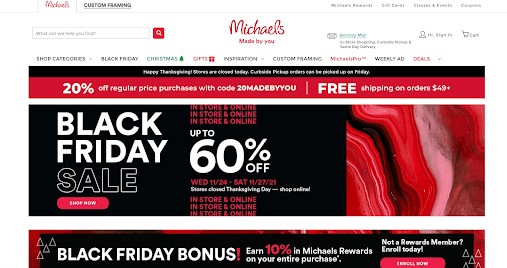
We love Michaels because it has a very clear and crisp look with a red and matching black design.
Their 20% OFF discount offer is clearly highlighted on top as a separate bar, as is the fact that they provide FREE Shipping (always a big draw with many ecommerce niches) for checkouts over a particular threshold ($49 in this case).
Their Hero section outlining the Black Friday offer is very striking, and you just can’t miss seeing the 60% OFF even if you wanted to. If we had to change anything about this, it would be making the Call to Action (CTA) more prominent.
Overall, a winning design and offer to boot!
Sock Club
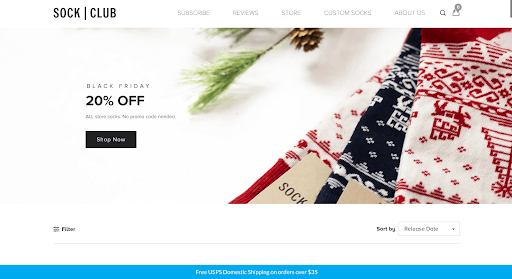
Apart from the brand name, we love how clean the design is. It seems like they’ve almost gone zen minimalistic with it. Loading speeds are always a worry for ecommerce website owners, and Sock Club seems to have a tab on it.
The Black Friday seasonal offer is hard to miss, although we wish the FREE Shipping offer mentioned at the bottom of the page were made more appealing and visible.
ProFlowers
An ecommerce store specializing in floral gifting with door-step delivery.
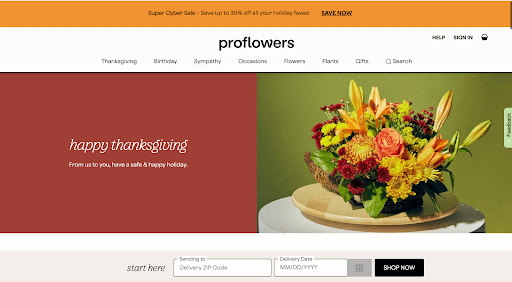
At first look, it’s apparent that the design is deliberately kept simple to draw more attention to the flowers. We loved how you are almost tempted to enter the Zip code and Delivery date and click the Shop Now button. Definitely high-converting!
If we had to change one thing, we would love to change some of the typography and font sizes (especially in the hero section), but maybe it’s just us!
Office Depot
An ecommerce store providing business consumables, products, and digital technology solutions to businesses of all sizes.
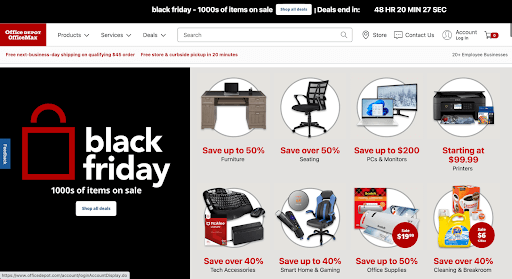
At first glance, Office depot’s home page just blasts you with the best offers on their top-selling products. The search box is prominently positioned for those looking for something else. Their FREE shipping, in-store and curbside pickup offers are clearly visible too.
The top bar also provides a strong sense of urgency to create a fear of missing out among casual browsers and regular customers alike, none of whom want to miss a steal deal like the ones they are seeing!
Belk
An ecommerce store selling private label fashion apparel, cosmetics, shoes & accessories for the entire family audience.
You are greeted with a stunning pop-up when you visit the home page first up.
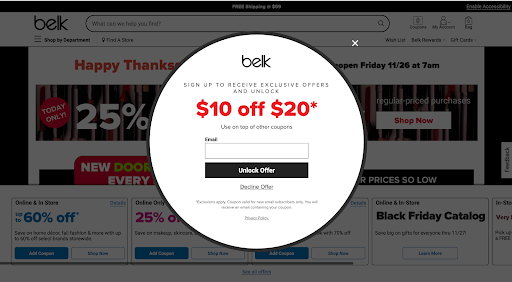
And if you thought that was impressive, wait until you see the home page—nothing left for guesses or imagination.
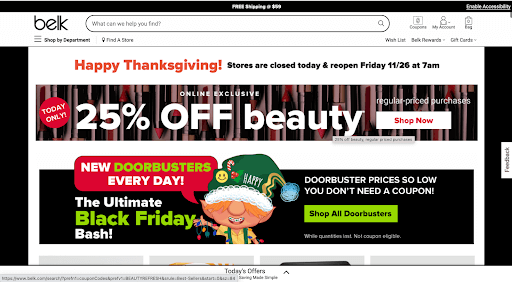
Clicking “Today’s offers” to the bottom pops up detailed and product-specific offers with visually engaging creatives.
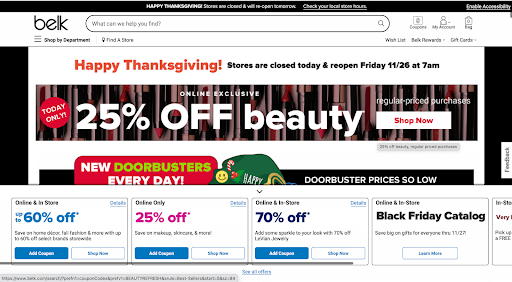
Leave this to us, and we’d probably make that “Today’s Offers” bar at the bottom more conspicuous and click-friendly.
There is no shortage of ecommerce websites that have had some level of conversion funnel optimization done on them.
Now, conversion rate optimization (CRO) is not a problem you can solve by throwing a landing page optimizer software at or conducting simple A/B testing once every six months and then resting on the laurels.
There’s no magic formula that can help improve website conversion or sales page conversion. You may see some quick wins, but you will only truly get significant results and improvement once you treat it like a process and each experiment as a case study.
Whether you are attacking a B2B website conversion problem or the plan is to help out a B2C business increase sales, the overall strategy will remain the same. However, depending upon business to business and niche to niche, your overall tactics and techniques will vary.
Conversion Rate Optimization Techniques & Best Practices
It’s challenging to optimize anything. From keywords to conversions, it may be overwhelming to start improving your current position and website.
To make it easier, we’ve broken down four CRO best practices that can boost your conversion rates.
Check Out Your Competitors But Don’t Copy Them
While your competitors may be your worst enemies, they can also be an incredible resource. Explore your top competitors’ websites to learn what’s convincing your industry audience to convert.
While you don’t want to copy their exact strategy, you want to understand why they’re so successful.
After identifying a few factors influencing your competition’s results, examine those metrics through your brand lens and apply your own filter. From there, you can make changes to your website that are consistent with your brand.
Clearly Define Your Goals
Before you start making changes to your website, you should set specific, measurable goals that’ll allow you to track your progress.
For example, your goal shouldn’t simply be to boost traffic. Instead, use a specific strategy to increase your traffic by a particular amount in a specific timeframe.
You can use the SMART goals system to create benchmarks you can track. SMART stands for specific, measurable, achievable, relevant, and time-bound.
As a result, you’ll create tangible goals that give you results.
Track Your CRO Strategies Using A/B and Multivariate Testing
Don’t limit yourself to one type of test when testing your website elements. Both A/B and multivariate tests can enable you to make data-driven decisions, but they each serve very different purposes. When combined, you can test various elements on your website.
A/B testing helps you compare various elements on two pages directly. This test is ideal for headlines, calls to action (CTAs), copy, and images and can produce helpful on-page results.
On the other hand, you can use a multivariate test to determine how variations across multiple page sections or elements would perform when combined. Multivariate testing identifies which elements have the most significant impact on audience engagement and can help you optimize one-off page elements.
You can better understand which optimization efforts will succeed by using both testing methods.
Be Patient With Your CRO Efforts
Like everything else in the digital marketing world, CRO doesn’t happen overnight. So be patient. Ideally, you should run your CRO tests for at least two weeks to ensure you have enough data to make an informed decision.
If your website has low traffic, you may want to run your tests for more than two weeks.
Allow your test to run until it reaches a 95-99% statistical significance level. Sample sizes heavily influence the significance of your experiment, so your sample size should be big enough to validate your results further. For example, you can rely on 200-300 conversions per variation but some experts recommend even 1,000 conversions per variation when doing your experiments.
Ecommerce Conversion Rate Optimization Tips
In an ecommerce context, the goal of Conversion Rate Optimization is to improve the overall user shopping experience, which could hopefully lead to increased conversions.
Ecommerce conversion rate (ecom conversion rate in short) is the proportion of visitors to the website who purchase something from the store (within a specific time frame). However, a conversion could also mean:
- Email Signups
- Adding product to their “Favorites” or “Wishlist”
- Adding product to a cart
- Online product purchase
- Social media share
Shopify Conversion Rate Optimization
Shopify conversion rate apps are plugins that make it easier to improve your online Shopify store conversion rate.
Depending on which aspect they help with, these plugins can be broadly categorized as under:
Landing Page Builder
These plugins or apps feature drag-and-drop builders to create high-converting pages for your Shopify ecommerce store.
A great example is the PageFly app that helps make your product stand out with high-converting pages, no matter your business size. It features ready-made templates to make Sales, Coming Soon, Product, Pricing, and FAQ pages with ease.
Social Proof Plugins
Use these to show proof of recent sales resulting in increased customer engagement. A great example is the Nudgify plugin that uses effects such as urgency, social proof, and scarcity to reduce the bounce rate and improve conversions.
Another great Shopify app is Judge.me, which lets you display star ratings and reviews about your products and Shopify store. You can increase your conversion rate and buyer engagement by using reviews and other user-generated content.
Email Marketing
The aim here is to enhance customer relationships by communicating regular, important, and sometimes urgent information. This helps reduce cart abandonment, get sales notifications through, etc.
Sender is a great unified messaging platform that helps you use the power of emails and SMS messages to attract, engage and convert prospects. Additionally, use the high-quality pop-up builder to build your email list, announce sales notifications and reduce cart abandonment.
Additionally, it’s possible to build complex, high-converting automation workflows that involve both emails and SMS.
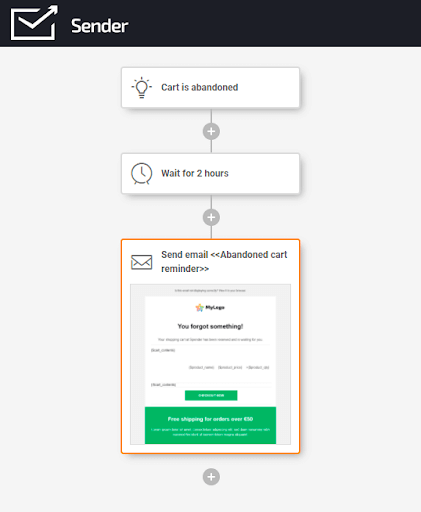
If the FREE plan involving 2,500 contacts and 15,000 emails every month does not wow you, we can’t wait to hear what else will!
Checkout Conversion Rate Optimization
Checkout abandonment is when the customer abandons the payment process after initiating it. As a result, you have incurred costs to acquire these customers and get them to the checkout stage.
As a result, these customers who’ve not converted represent lost revenue for your business. Hence it’s essential to focus on reducing the checkout abandonment rate.
Some best practices for checkout conversion rate optimization include:
- Ensure that the checkout page design is mobile-friendly and responsive.
- Reduce friction for first-time buyers by allowing guest checkouts. Allowing one-time buyers to input their email and complete their purchase is a great way to encourage them to come again.
- Provide multiple payment options so if a payment gateway fails or something untoward happens, the prospect always has an alternative path he can take almost immediately.
- Avoid surprising customers with hidden costs during checkout. This would almost be the perfect way to piss them off! These could include Shipping & Handling, Taxes, etc. If you must charge them, then ensure they know about it on the Product page itself or as soon as they add it to the cart.
- Provide FREE Shipping wherever you can. It’s a huge crowd-pleaser.
- Provide customers with information on how to contact support if they have any questions. E.g., Email address, Toll-free number, Website Chat are great options.
- Offer Discount Coupons to first-time customers to sweeten the deal. Pair this up with urgency and scarcity, and you will end up with a conversion more often than not.
Product Page Conversion Optimization
We can all agree that the product page is where most of your customers decide whether they will buy your product or not. Therefore nailing this could be a crucial part of improving your ecommerce store conversion rate.
Some best practices that need to be a part of your product page conversion optimization process:
Visually Stunning Product Images
Make it a point only to use high-quality product media, i.e., images and videos. There is an upfront investment in creating, setting up, optimizing, and maintaining high-resolution images and media, but the conversions will make it worthwhile.
Investing in high-quality product photos right away is a great way to boost conversions and set yourself apart from the competition.
Improve Your Ecommerce Store Site Speed
The US ecommerce market is valued at over $860 billion (2020), with over 1.8 million online retailers.
Even a delay of a single second can result in a 7% reduction in conversions. In the case of an ecommerce site that makes $5,000 per day, a 1-second delay could result in $125,000 in revenue lost.
Include a Prominent Call to Action (CTA)
Your CTA should be clear, crisp, and visually prominent. Something the customer cannot miss. For instance, check out Amazon US’s product page for a novel below.
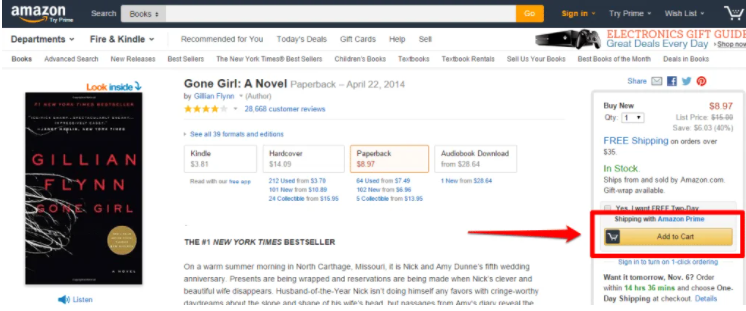
Create a Fear of Missing Out by Including Scarcity, Urgency, or Both
For example, the Amazon India site indicates that there are quite possibly only three units of this high-quality watch left in stock and that the prospect needs to hurry if he wants it.
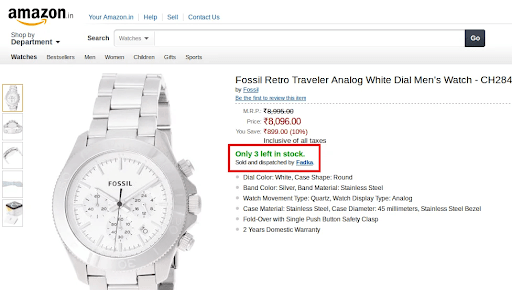
Improve Trust in the Prospect by Providing Visual Badges & Customer Reviews
People buy products they trust, so if you want them to buy yours, you must convince them that your store is a perfectly safe place to shop and that what they are buying is authentic.
The best way to convey this is by adding trust badges and statements to your product pages. Examples include:

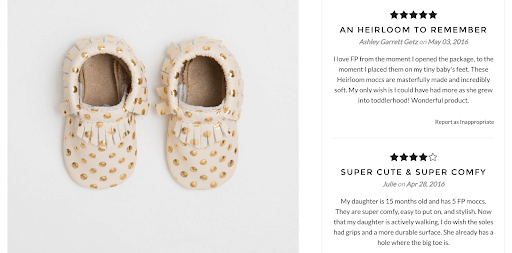
Use FAQs to Address Customer Objections
Answering the most common questions customers ask themselves right on the product page is a great way to stall any objections they might have before the purchase.
Just ensure that the information being explained is valuable and relevant. For example, you could include details about the Product’s USP (Unique Selling Point) or features, Payment Options, Shipping costs, etc.
Overall it helps to have built your ecommerce website over a solid foundational platform such as Shopify, Woocommerce, Magento, BigCommerce, or Wix. Ensure it has excellent visual and UI/ UX design, excellent product imagery, and fantastic bootload speed. Every other optimization can rest on top of this fundamental stack.
Also, software such as Google Analytics can give you a ton of information about the traffic entering your ecommerce website, the device used (mobile, desktop, etc.), and other crucial information that could help you further optimize conversions.
Conversion Rate Optimization Tools
CRO tools will help you capture more leads on your website, thus improving your CRO analytics.
While most conversion-focused content has a call to action or built-in form, these tools serve as additional lead capture mechanisms to increase the number of leads who convert on your content.
BuzzSumo
With BuzzSumo, you just enter the topic or keyword, and the software compiles the most shared and linked content on that subject. Time frames range from the previous day to the last week, month, or year.
For example, if you want to optimize the landing page for your new webinar on dog fashion, enter “dog fashion.” BuzzSumo will then give you the best resources, articles, videos, and more.
You’ll then be able to explore some of the key elements that made these pages popular. With that, you can incorporate them into your own content.
Really Good Emails
If you want to get your message across in today’s marketing landscape, you should be familiar with visual communication and design.
Don’t know anything about either? Enter Really Good Emails.
Really Good Emails has a database of the best-designed emails from the world’s most innovative brands. You can use this as a resource to see how you can design your email to get your message across as quickly as possible.
Google Analytics
Google Analytics is a free tool for tracking your website visitors. It enables you to see how long it takes visitors to leave your pages, if they complete goals from a specific path, and which sources bring people to your website.
Google Analytics lets you see which keywords people use to find your webpage, what devices they’re searching on, and uncover demographic data. However, your website visitors don’t have any specific emails or contact information attached to them.
HubSpot
HubSpot’s platform provides you with detailed contact information on current and prospective customers in your database. It also includes a dashboard that displays a high-level view of which marketing efforts are paying off and converting and which ones aren’t.
HubSpot’s system starts with an exit-intent popup CTA, then syncs with your website’s existing forms to learn about your website visitors and their path through your pages.
HelloBar
HelloBar is a lead generation tool that helps you add a popup form to your website to grow your email list, highlight a sale, promote your social pages, or implement other lead generation strategies.
The free version allows you to make one modal that appears to every tenth visitor. Premium plans, on the other hand, provide a more advanced call to action (CTA) option.
The Conversion Rate Optimization (CRO) Debate
Simply put, there is no debate. Most website and ecommerce store owners like you realize that more traffic is not the answer to more sales. You understand the importance of Conversion Rate Optimization and how it helps you generate additional revenue for the same investment.
Remember that this isn’t a one-time project but rather a constant activity that you will need a dedicated team to keep checking. But the rewards will make it so worth it.
Also read:
Content Contributor – Santosh Balakrishnan
